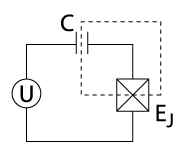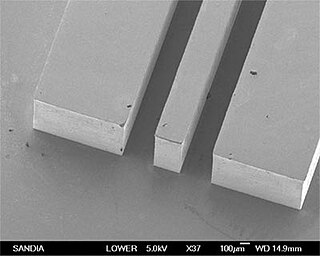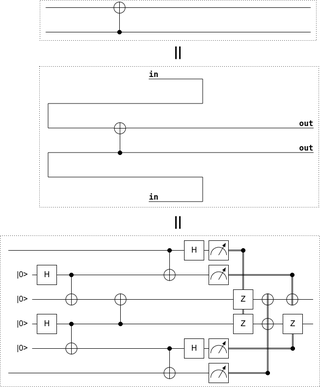Related Research Articles
Quantum error correction (QEC) is used in quantum computing to protect quantum information from errors due to decoherence and other quantum noise. Quantum error correction is theorised as essential to achieve fault tolerant quantum computing that can reduce the effects of noise on stored quantum information, faulty quantum gates, faulty quantum preparation, and faulty measurements. This would allow algorithms of greater circuit depth.

In quantum computing, a charge qubit is a qubit whose basis states are charge states. In superconducting quantum computing, a charge qubit is formed by a tiny superconducting island coupled by a Josephson junction to a superconducting reservoir. The state of the qubit is determined by the number of Cooper pairs that have tunneled across the junction. In contrast with the charge state of an atomic or molecular ion, the charge states of such an "island" involve a macroscopic number of conduction electrons of the island. The quantum superposition of charge states can be achieved by tuning the gate voltage U that controls the chemical potential of the island. The charge qubit is typically read-out by electrostatically coupling the island to an extremely sensitive electrometer such as the radio-frequency single-electron transistor.
Superconducting quantum computing is a branch of solid state quantum computing that implements superconducting electronic circuits using superconducting qubits as artificial atoms, or quantum dots. For superconducting qubits, the two logic states are the ground state and the excited state, denoted respectively. Research in superconducting quantum computing is conducted by companies such as Google, IBM, IMEC, BBN Technologies, Rigetti, and Intel. Many recently developed QPUs use superconducting architecture.
A quantum bus is a device which can be used to store or transfer information between independent qubits in a quantum computer, or combine two qubits into a superposition. It is the quantum analog of a classical bus.
In quantum computing, and more specifically in superconducting quantum computing, the phase qubit is a superconducting device based on the superconductor–insulator–superconductor (SIS) Josephson junction, designed to operate as a quantum bit, or qubit.
Steven M. Girvin is an American physicist who is the Eugene Higgins Professor of Physics at Yale University and who served as deputy provost for research at Yale from 2007 to 2017. Girvin is noted for his theoretical work on quantum many body systems such as the fractional quantum Hall effect, and as co-developer of circuit QED, the application of the ideas of quantum optics to superconducting microwave circuits. Circuit QED is now the leading architecture for construction of quantum computers based on superconducting qubits.

In quantum computing, and more specifically in superconducting quantum computing, a transmon is a type of superconducting charge qubit designed to have reduced sensitivity to charge noise. The transmon was developed by Robert J. Schoelkopf, Michel Devoret, Steven M. Girvin, and their colleagues at Yale University in 2007. Its name is an abbreviation of the term transmission line shunted plasma oscillation qubit; one which consists of a Cooper-pair box "where the two superconductors are also [capacitively] shunted in order to decrease the sensitivity to charge noise, while maintaining a sufficient anharmonicity for selective qubit control".
In quantum mechanics, the cat state, named after Schrödinger's cat, is a quantum state composed of two diametrically opposed conditions at the same time, such as the possibilities that a cat is alive and dead at the same time.

Coplanar waveguide is a type of electrical planar transmission line which can be fabricated using printed circuit board technology, and is used to convey microwave-frequency signals. On a smaller scale, coplanar waveguide transmission lines are also built into monolithic microwave integrated circuits.

Robert J. Schoelkopf III is an American physicist, most noted for his work on quantum computing as one of the inventors of superconducting qubits. Schoelkopf's main research areas are quantum transport, single-electron devices, and charge dynamics in nanostructures. His research utilizes quantum-effect and single-electron devices, both for fundamental physical studies and for applications. Techniques often include high-speed, high-sensitivity measurements performed on nanostructures at low temperatures. Schoelkopf serves as director of the Yale Center for Microelectronic Materials and Structures and as associate director of the Yale Institute for Nanoscience and Quantum Engineering. Since 2014, Schoelkopf is also the Director of the Yale Quantum Institute. He is Professor of Physics and Sterling Professor of Applied Physics at Yale University. The title of Sterling Professor is the highest honor bestowed upon Yale faculty.

Michel Devoret is a French physicist and F. W. Beinecke Professor of Applied Physics at Yale University. He also holds a position as the Director of the Applied Physics Nanofabrication Lab at Yale. He is known for his pioneering work on macroscopic quantum tunneling, and the single-electron pump as well as in groundbreaking contributions to initiating the fields of circuit quantum electrodynamics and quantronics.

Irfan Siddiqi is an American physicist and currently a professor of physics at the University of California, Berkeley and a faculty scientist at Lawrence Berkeley National Laboratory (LBNL). He currently is the director of the Quantum Nanoelectronics Laboratory at UC Berkeley and the Advanced Quantum Testbed at LBNL. Siddiqi is known for groundbreaking contributions to the field of superconducting quantum circuits, including dispersive single-shot readout of superconducting quantum bits, quantum feedback, observation of single quantum trajectories, and near-quantum limited microwave frequency amplification. In addition to other honors, for his pioneering work in superconducting devices, he was awarded with the American Physical Society George E. Valley, Jr. Prize in 2006, "for the development of the Josephson bifurcation amplifier for ultra-sensitive measurements at the quantum limit." Siddiqi is a fellow of the American Physical Society and a recipient of the UC Berkeley Distinguished Teaching Award in 2016.
Cloud-based quantum computing is the invocation of quantum emulators, simulators or processors through the cloud. Increasingly, cloud services are being looked on as the method for providing access to quantum processing. Quantum computers achieve their massive computing power by initiating quantum physics into processing power and when users are allowed access to these quantum-powered computers through the internet it is known as quantum computing within the cloud.

Andreas Wallraff is a German physicist who conducts research in quantum information processing and quantum optics. He has taught as a professor at ETH Zürich in Zürich, Switzerland since 2006. He worked as a research scientist with Robert J. Schoelkopf at Yale University from 2002 to 2005, during which time he performed experiments in which the coherent interaction of a single photon with a single quantum electronic circuit was observed for the first time. His current work at ETH Zürich focuses on hybrid quantum systems combining superconducting electronic circuits with semiconductor quantum dots and individual Rydberg atoms as well as quantum error correction with superconducting qubits.

Jerry M. Chow is a physicist who conducts research in quantum information processing. He has worked as the manager of the Experimental Quantum Computing group at the IBM Thomas J. Watson Research Center in Yorktown Heights, New York since 2014 and is the primary investigator of the IBM team for the IARPA Multi-Qubit Coherent Operations and Logical Qubits programs. After graduating magna cum laude with a B.A. in physics and M.S. in applied mathematics from Harvard University, he went on to earn his Ph.D. in 2010 under Robert J. Schoelkopf at Yale University. While at Yale, he participated in experiments in which superconducting qubits were coupled via a cavity bus for the first time and two-qubit algorithms were executed on a superconducting quantum processor.
In quantum computing, a qubit is a unit of information analogous to a bit in classical computing, but it is affected by quantum mechanical properties such as superposition and entanglement which allow qubits to be in some ways more powerful than classical bits for some tasks. Qubits are used in quantum circuits and quantum algorithms composed of quantum logic gates to solve computational problems, where they are used for input/output and intermediate computations.

IBM Quantum System One is the first circuit-based commercial quantum computer, introduced by IBM in January 2019.

Quantum gate teleportation is a quantum circuit construction where a gate is applied to target qubits by first applying the gate to an entangled state and then teleporting the target qubits through that entangled state.
References
- ↑ "Princeton Engineering - Princeton introduces a Ph.D. program at intersection of quantum physics and information theory". Princeton Engineering. Retrieved 2023-11-16.
- ↑ "Andrew Houck". MIT Technology Review. Retrieved 2023-07-07.
- ↑ Houck, Andrew A.; Türeci, Hakan E.; Koch, Jens (April 2012). "On-chip quantum simulation with superconducting circuits". Nature Physics. 8 (4): 292–299. doi:10.1038/nphys2251. ISSN 1745-2481.
- ↑ Kollár, Alicia J.; Fitzpatrick, Mattias; Houck, Andrew A. (July 2019). "Hyperbolic lattices in circuit quantum electrodynamics". Nature. 571 (7763): 45–50. arXiv: 1802.09549 . doi:10.1038/s41586-019-1348-3. ISSN 1476-4687.
- ↑ "Princeton - News - Princeton Names 2000 Valedictorian, Salutatorian". pr.princeton.edu. Retrieved 2023-07-07.
- ↑ Koch, Jens; Yu, Terri M.; Gambetta, Jay; Houck, A. A.; Schuster, D. I.; Majer, J.; Blais, Alexandre; Devoret, M. H.; Girvin, S. M.; Schoelkopf, R. J. (2007-10-12). "Charge-insensitive qubit design derived from the Cooper pair box". Physical Review A. 76 (4): 042319. arXiv: cond-mat/0703002 . doi:10.1103/PhysRevA.76.042319.
- ↑ Schreier, J. A.; Houck, A. A.; Koch, Jens; Schuster, D. I.; Johnson, B. R.; Chow, J. M.; Gambetta, J. M.; Majer, J.; Frunzio, L.; Devoret, M. H.; Girvin, S. M.; Schoelkopf, R. J. (2008-05-12). "Suppressing charge noise decoherence in superconducting charge qubits". Physical Review B. 77 (18): 180502. arXiv: 0712.3581 . doi:10.1103/PhysRevB.77.180502.
- ↑ Qiskit (2022-09-28). "How The First Superconducting Qubit Changed Quantum Computing Forever". Qiskit. Retrieved 2023-07-07.
- ↑ Metz, Cade (2017-11-13). "Yale Professors Race Google and IBM to the First Quantum Computer". The New York Times. ISSN 0362-4331 . Retrieved 2023-07-07.
- ↑ Place, Alexander P. M.; Rodgers, Lila V. H.; Mundada, Pranav; Smitham, Basil M.; Fitzpatrick, Mattias; Leng, Zhaoqi; Premkumar, Anjali; Bryon, Jacob; Vrajitoarea, Andrei; Sussman, Sara; Cheng, Guangming; Madhavan, Trisha; Babla, Harshvardhan K.; Le, Xuan Hoang; Gang, Youqi (2021-03-19). "New material platform for superconducting transmon qubits with coherence times exceeding 0.3 milliseconds". Nature Communications. 12 (1): 1779. doi: 10.1038/s41467-021-22030-5 . ISSN 2041-1723. PMC 7979772 .
- ↑ Sharlach, Molly (July 15, 2019). "Strange warping geometry helps to push scientific boundaries". Princeton University. Retrieved 2023-11-16.
- ↑ "Q&A: Andrew Houck '00 on Princeton's New Quantum Science Institute". Princeton Alumni Weekly. 2023-09-17. Retrieved 2023-11-16.